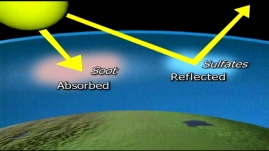While Earth's average temperature is increasing, scientists have observed that warming trend is not evenly distributed across Earth's surface. Some areas are warming rapidly, while others are experiencing a local cooling trend. Regional precipitation patterns have also been affected; some regions are experiencing more dryness while others are seeing increased rainfall and flooding.
Scientists have identified atmospheric particles as contributing to regional differences in atmospheric warming and cooling. These particles suspended in the atmosphere are called aerosols. They are both solid and liquid particles of varying sizes, some of which occur naturally and some which are the result of human activity. Naturally occurring aerosols come from sources such as fog, vegetation, smoke from fires, dust from volcanoes, and sea spray. These compose approximately 90% of the aerosols in our atmosphere; the remaining 10% are pollutants from such activities as driving cars, manufacturing, heating homes, and clearing land for crop production.
Aerosols are known for their negative effects on air quality and human health—much attention has been given to the effects of smog and air pollution. But aerosols also affect climate directly by reflecting or absorbing sunlight, as well as by seeding clouds and changing precipitation patterns.
While carbon dioxide is blamed as the leading pollutant in climate change, a new study says another form of carbon, so-called black carbon (BC), also plays a critical role. Black carbon, a soot component, has a strong warming influence on the atmosphere because it absorbs incoming solar radiation and generates heat in the atmosphere. BC can affect regional cloud formation and precipitation patterns. When deposited on snow and ice, BC absorbs sunlight and generates heat, which warms the air above and melts the snow and ice below. Black carbon is the result of incomplete combustion from sources such as power plants, diesel engines, and even the cook stoves used in the developing world.
Sulfates, on the other hand, scatter incoming solar radiation, causing atmospheric cooling. These microscopic particles, smaller than a millionth of a meter, are suspended in the air, where they tend to increase cloud formation and reflectivity. Sulfates are produced primarily from sulfur dioxide (SO2) during the combustion of fossil fuels.
While black carbon absorbs radiation and sulfates tend to reflect radiation, they do not necessarily cancel each other out. Instead, uneven distribution of these atmospheric pollutants across the globe accounts for some of the variability in warming and cooling patterns. Aerosols add to the complexity of understanding our dynamically changing climate system.
